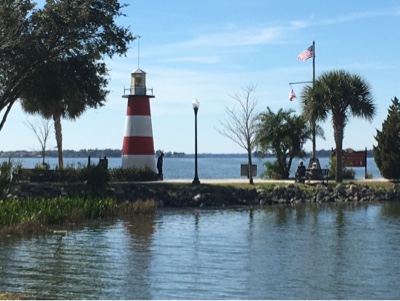Mount Dora, founded in 1880, is known as the antiquing capital of Florida with more dealers here than anywhere else in the state.
Much of the action is centered at Renninger's Twin Markets, a 117-acre complex on the east side of town where hundreds of dealers set up every weekend. Tim and I once enjoyed a day spent antiquing, but with our current RV home's square footage, we don't have much incentive for that type of shopping now. Consequently, we passed up the crowds at Renninger's to focus instead on Mount Dora's quaint and charming downtown.
We parked near the iconic Donnelly House, built in 1893 by Pittsburgh native John P. Donnelly who came to Mount Dora in 1879 and subsequently served as its first mayor.
Much of the action is centered at Renninger's Twin Markets, a 117-acre complex on the east side of town where hundreds of dealers set up every weekend. Tim and I once enjoyed a day spent antiquing, but with our current RV home's square footage, we don't have much incentive for that type of shopping now. Consequently, we passed up the crowds at Renninger's to focus instead on Mount Dora's quaint and charming downtown.
We parked near the iconic Donnelly House, built in 1893 by Pittsburgh native John P. Donnelly who came to Mount Dora in 1879 and subsequently served as its first mayor.
Now owned by the Masons, a fraternal organization, the home is rarely open to the public. Unfortunately, we did not arrive on one of those days.
So we walked a block to downtown where
So we walked a block to downtown where
we window-shopped,
lunched at the Copacabana Cuban Cafe,
found ice cream for dessert from the unlikely named Coffee Pot shop, and
visited a tasting bar, The Mount Dora Olive Oil Company. There, despite the calories we'd already consumed, we sampled a few of over 65 varieties of olive oil and vinegars.
Then we strolled--should I say, waddled?--to a town landmark since its opening in 1883, The Lakeside Inn. President Calvin Coolidge and his wife Grace once enjoyed a month-long stay in its gracious comfort.
The inn is a popular place for weddings with beautifully landscaped grounds and
a picturesque gazebo.
All face the shores of Lake Dora, one of more than 1,400 lakes here in Lake County.
Just across the street from the inn is Mount Dora's Lawn Bowling Club. There players on outdoor, artificial turf courts try to roll balls so that they stop close to a smaller ball called a "jack" or "kitty". We watched a gentleman play and concluded that the game is more difficult than the rules would lead one to believe.
Our final stop of the day was at the Mount Dora Lighthouse. It's not a real lighthouse (it's only 35 feet tall) but I imagine it would add interest to a sunset photo of Lake Dora.
Just across the street from the inn is Mount Dora's Lawn Bowling Club. There players on outdoor, artificial turf courts try to roll balls so that they stop close to a smaller ball called a "jack" or "kitty". We watched a gentleman play and concluded that the game is more difficult than the rules would lead one to believe.
Our final stop of the day was at the Mount Dora Lighthouse. It's not a real lighthouse (it's only 35 feet tall) but I imagine it would add interest to a sunset photo of Lake Dora.













































